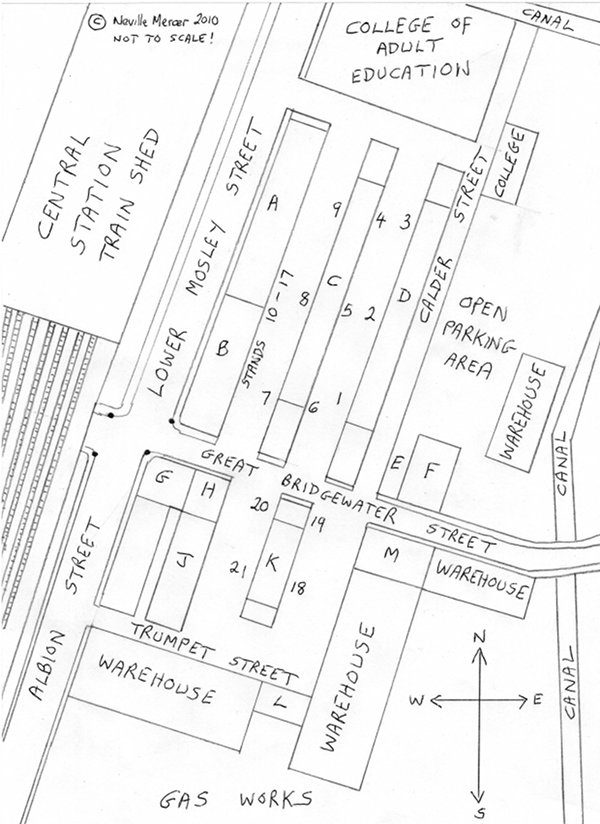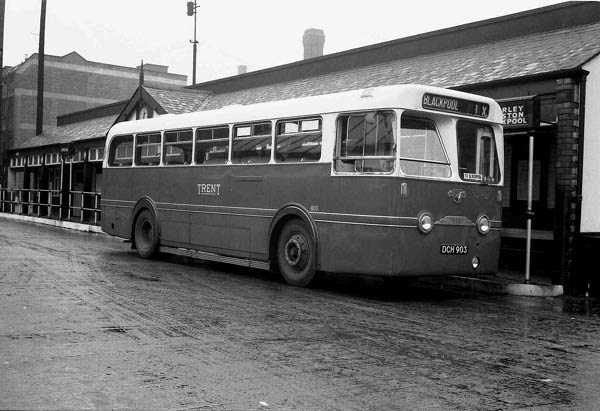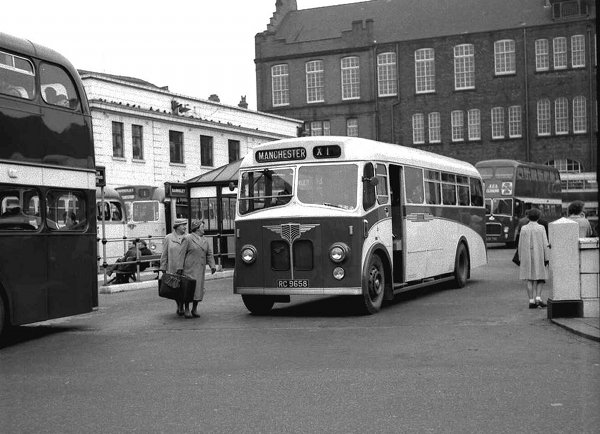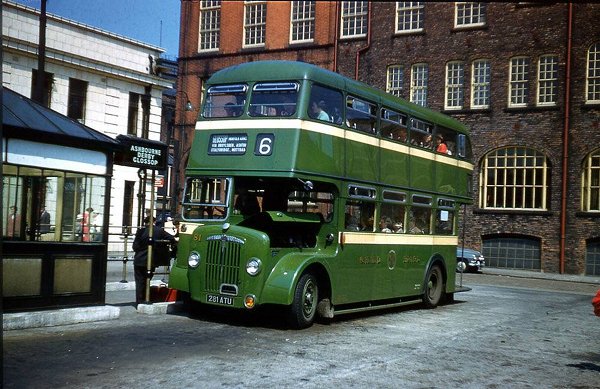Lower Mosley Street Manchester Part 2
Lower Mosley Street Manchester - Part 2
Not read Part 1 Click here
The modern era
The declaration of war in September 1939 brought a temporary end to the expansion of services from Lower Mosley Street. Most services were suspended for the duration although the Bradford via Halifax service and the number 6 to Glossop continued to run at a reduced frequency throughout the war and anecdotal evidence suggests that the Ribble expresses to Clitheroe via Accrington and to Burnley via Rawtenstall also survived in some form for most of the conflict. The bus station was far from quiet, however, as it was used by the military for coaches running to army camps and aerodromes not easily accessible by train. During the Luftwaffe bombing raids of 1940-41 a searchlight and anti-aircraft gun were driven each night on to the newly acquired “southern half” of the bus station.
After the end of the war services were restored at a rather pedestrian rate as Britain’s bus companies (North Western included) needed time to recover from the effects of worn out rolling stock and an inadequate supply of replacement vehicles. Pre-war express networks were not to be fully restored until the end of 1950. In contrast, the level of passenger demand for those services was higher than ever before as war-weary citizens yearned for leisure and novelty. Anyone seeking evidence of this staggeringly large demand should take a look at pages 94/95 of Eric Ogden’s book “North Western Vol.2” which show the bus station besieged by hordes of would-be travellers.
As a result an investment was made in the southern half of the bus station. Previously used largely as an “overflow” arrivals and parking area, it acquired a central “island” platform (stands 18-21) along with an enclosed shelter which reflected the earlier structure on the north side “island”.
Few new services were introduced during the 1950s as the network offered by North Western, Ribble, and their joint operators was already fairly comprehensive. An exception was a new route from Manchester to Chesterfield which started in June 1954, jointly operated by North Western and East Midland Motor Services.
By 1960 passenger numbers had started to decline as private car ownership became more widespread. In response North Western began new seasonal routes to resorts not previously served including Cleethorpes, Ramsgate, Skegness, and Southend. Despite the gradual decline in traffic the bus station remained a busy place (more like a frantic one on summer weekends) and there never seemed to be enough space available. This led to an increasing usage of the car park behind Isherwoods Garage for departures to “rarer” destinations.
This was also the year in which North Western finally introduced route numbers for its express services. Previously only those routes which had been allocated route numbers by their joint operators had worn these on North Western workings (where possible – many of North Western’s coaches of the time lacked a route number blind). A problem arose with the London service where the joint operator, Midland Red, had identified the various permutations of the route by a letter rather than a number. North Western’s solution was to number all London journeys “X5” but with a suffix letter to indicate the routing. In this fashion the main daytime services to London became the X5D, X5E, and X5L, the overnight journeys the X5M and X5N, and short workings to Birmingham via Altrincham (Midland Red’s “P”) became North Western’s “X5P”.
Map of Lower Mosley Street circa 1965

Key to Map
|
A |
Main bus station office building incorporating booking hall, waiting room, toilets, facilities for crews to sign on/off duty, and inspectors’ accommodation. |
| B | Main platform shelter incorporating queues for stands 10 – 17. |
| C | Northern island platform shelter for stands 4 – 9. |
| D | Blackpool” shelter for stands 1 – 3. |
| E | Newspaper kiosk. An adjacent stall sold fresh fruit in summer. Immediately to the north of the kiosk was the allocated parking space of the Leyland TD5 mobile staff canteen DDK 117. |
| F | Isherwoods Garage. The open parking area to the north, owned by the garage, was used for cars on Monday to Friday and for buses and coaches at weekends. |
| G | The Britons Protection public house. |
| H | The Golden Horse cafe. |
| J | Ribble Motor Services’ Manchester depot. Access for vehicles was via an entrance on Back Albion Street, the narrow dead-end shown alongside the depot. |
| K | Southern island platform shelter for stands 18 – 21. |
| L | Samuel Hall, the saw doctor’s premises. |
| M | The Bus Station Cafe (in the lower part of the warehouse building). |
Most of the warehouses shown on the map were originally built to serve the Manchester and Salford Junction Canal but by the 1960s they were in use by a mixture of storage companies and textile wholesalers.
I first visited Lower Mosley Street in May 1962 and was a regular pilgrim to the site for the subsequent eleven years, sometimes to catch a coach to more distant locations, sometimes to spend the best part of the day there watching the comings and goings. Sadly few of my notes from that era survive, so the first-hand description of the place that follows is dependent upon memory and I would ask forgiveness for any errors.
An Enthusiast's Viewpoint
On a typical Saturday morning in the summers of 1962-69 I would aim to arrive at Lower Mosley Street by 8 am, giving me a chance to catch sight of the early departures to London, North Wales, Nottingham, and Scotland. In reality (like most enthusiasts) I had my own method for inspecting the vehicles in the “right” order, but for the sake of clarity the material is presented here stand by stand in numerical order.
Stands 1-3 were on the eastern side of the original bus station, with 1 marked for “Chorley Preston Blackpool” and 2/3 for “Specials” and “Excursions” respectively. Despite these latter headings I never saw any vehicles parked on this platform which were not deployed on the X60/X70 expresses to Blackpool. Besides the vehicles of the three joint operators on these services, North Western, Ribble, and Lancashire United (all three of which might use anything in their respective fleets) , buses belonging to Manchester Corporation – usually double-deckers with open rear platforms – were frequently used in the peak summer period, displaying “60X” and operating non-stop to Blackpool. Rarer but not unknown were double-deckers hired in from S.H.M.D. and Mayne of Manchester. In addition vehicles belonging to Trent would pass by, operating the through journeys on the X1 (from Derby) and X2 (Nottingham) which became X60s at Manchester. Even more interesting were the occasional surprises which turned up out of the blue. Particular examples which proved impossible to forget were an East Kent Reliance/Park Royal coach in the summer of 1964 (I had to know why and asked the driver – it turned out to have brought a private hire party to Blackpool and made the mistake of overnighting at Ribble’s Devonshire Road depot where an inspector spotted it and discovered that it wasn’t due to return to base until Sunday!) and an East Yorkshire Panther bus in 1967 which had strayed to Blackpool as a duplicate on EYMS’s own express service and, again, been shanghaied by a Ribble inspector. How they handled insurance cover in the absence of a written hire agreement remains a mystery, but there was something for everyone on this platform on a busy Saturday.
 The though journeys on the X1/X60 interchange took six hours to get from Derby to Blackpool, so the Trent manager who allocated this 1952 all-Leyland Royal Tiger service bus to the route was either hard-pressed or didn’t like passengers! Fleet number 803 (DCH 903) is seen parked at the Blackpool stand half-way through its bottom-numbing marathon. Strangely, the vehicle’s destination blind included “Blackpool” yet its route number blind had no letter “X” on its left-hand track, thus the display of “1X”.
The though journeys on the X1/X60 interchange took six hours to get from Derby to Blackpool, so the Trent manager who allocated this 1952 all-Leyland Royal Tiger service bus to the route was either hard-pressed or didn’t like passengers! Fleet number 803 (DCH 903) is seen parked at the Blackpool stand half-way through its bottom-numbing marathon. Strangely, the vehicle’s destination blind included “Blackpool” yet its route number blind had no letter “X” on its left-hand track, thus the display of “1X”.
(J Kaye)
 Conversely, for a journey scheduled to turn round at Manchester, Trent managed to roster a dual-purpose vehicle with more luxurious seating. The chassis of fleet number 301 (RC 9658) was, admittedly, older than that of the Royal Tiger, being a 1947 AEC Regal. The 39-seat fully-fronted bodywork, however, was much younger and had been fitted in 1958. On arrival at Lower Mosley Street 301 has found stand 4 blocked off by a Ribble PD3 and the driver seems uncertain of what to do next.
Conversely, for a journey scheduled to turn round at Manchester, Trent managed to roster a dual-purpose vehicle with more luxurious seating. The chassis of fleet number 301 (RC 9658) was, admittedly, older than that of the Royal Tiger, being a 1947 AEC Regal. The 39-seat fully-fronted bodywork, however, was much younger and had been fitted in 1958. On arrival at Lower Mosley Street 301 has found stand 4 blocked off by a Ribble PD3 and the driver seems uncertain of what to do next.
(J Kaye)
Moving westwards to the “island” platform, stand 4 was used by services to “Ashbourne Derby Glossop”, specifically the X1 to Derby (typically operated by North Western Leopards with Y-type bodywork, similar machines from Trent although they could use almost anything in their fleet on a busy weekend, and a miscellany of Ribble vehicles working through from Blackpool ranging from all-Leyland Royal Tiger coaches to Leopards with B.E.T style bus bodywork) and the 6 to Glossop (jointly operated by North Western, usually with Renowns from 1964 onwards, Manchester with assorted PD2s, Ashton-under-Lyne with PD2s and then Atlanteans – both bodied by Roe, and S.H.M.D. with PD2s and then Fleetlines with Northern Counties bodywork). The Ashton vehicles in blue and the S.H.M.D. in green provided a welcome contrast to the sea of red in various shades which predominated at Lower Mosley Street.
 In 1955/56 S.H.M.D. experimented with central entrance double-deckers, but in 1957 they reverted to the conventional rear entrance layout as illustrated by fleet number 81 (281 ATU), a Daimler CVG6 with Northern Counties H64R bodywork. The Daimler is on stand 4 with passengers on board for a service 6 departure to Glossop, but the raised bonnet indicates that all may not be well.
In 1955/56 S.H.M.D. experimented with central entrance double-deckers, but in 1957 they reverted to the conventional rear entrance layout as illustrated by fleet number 81 (281 ATU), a Daimler CVG6 with Northern Counties H64R bodywork. The Daimler is on stand 4 with passengers on board for a service 6 departure to Glossop, but the raised bonnet indicates that all may not be well.
(J Kaye)
The remainder of this side of the “island” was Ribble country with stand 5 “Burnley Nelson Colne” handling the half-hourly X43 to these destinations via Rawtenstall (with most journeys continuing to Skipton in Yorkshire) and the much less frequent X4/X14 which operated to Burnley via Todmorden with some journeys continuing to Blackpool or Morecambe. Stand 6 “Accrington Great Harwood Clitheroe” was home to Ribble’s X3/X13 (to Great Harwood) and X23 to Clitheroe, all three services operating via Haslingden and Accrington to provide a half-hourly frequency. Vehicles in use by 1965 were (typically) “White Lady” Atlantean coaches or fully-fronted Met-Cam PD3s on the X43, single-deck coaches or BET bodied Leopard buses on the X4/X14, and bus-bodied Atlanteans or BET Leopards on the X3/X13/X23.
The other side of this “island” platform provided stands 7-9. Stand 7 “Cheadle Bramhall Poynton” served North Western’s route 32 to Higher Poynton and Middlewood, usually operated by single-decker buses and half-hourly. Stand 8 “Barnsley” catered for the X19 and X20 to that Yorkshire town via two extremely scenic routes. Between them they provided an hourly frequency on Saturdays, less frequent on other days. North Western and Yorkshire Traction both favoured dual-purpose vehicles for these routes, although for a short time in the mid 1960s North Western made a habit of using Bedford VAL14/Strachan B52F buses (drafted in from Altrincham garage) on Saturday workings on the Holmfirth variation. As far as I am aware there were no difficult canal bridges on this route! Another habitual user of this stand (at least on Saturdays) was the X2 to Nottingham although in theory this should have departed from the south side of the bus station. Inspectors would (hopefully) redirect all intending passengers. Stand 9 at the back of the platform was the exclusive preserve of North Western’s half-hourly service 28 to Hayfield (at the foot of Kinder Scout) which seemed to feature the company’s newest double-deckers – it passed the operator’s headquarters at Charles Street in Stockport.
The platform closest to Lower Mosley Street, containing the booking hall, offices, etc, was – as previously mentioned – incapable of holding more than four vehicles yet featured stands 10-17. These were, in reality, queuing up lines rather than proper stands and inspectors would arrive to herd passengers to the vehicles whether parked at the back of the platform or dallying in the middle lane and creating a tailback onto Lower Mosley Street itself. Stand 10 was “Dewsbury Leeds Newcastle-upon-Tyne”. Stand 11 was a bit peculiar and carried the legend “Bankfield Road” on its destination sign. This was an obscure back road in Cheadle Hulme with no apparent scheduled connection to Lower Mosley Street. In reality this was used as a weekend overflow for Stand 10, providing a separate queue for passengers heading to Middlesbrough on days when this destination was served by its own coach rather than by changing at Leeds. Stand 12 “Stockport Chapel-en-le-Frith Buxton” was for North Western’s half-hourly 27, usually operated by the latest single-deck saloons including the “banana split” Reliance dual-purpose vehicles. While Stand 10 catered for the X97 to Leeds and Newcastle-upon-Tyne, Stand 13 served passengers on their way to Liverpool on the X97 (via Altrincham) and X99 (via Eccles). These routes were jointly operated by North Western, Lancashire United, West Yorkshire, Yorkshire Woollen, Northern General, and United Automobile Services, although the vehicles of the last two operators were significantly rarer than the other four participants. United vehicles were particularly unusual as they would normally be restricted to the Middlesbrough to Leeds segment of the X99 service. The X97/X99 provided an hourly frequency in each direction between Liverpool and Leeds.
Still on the western platform, Stand 14 was allocated to North Western’s hourly service 29 “Cheadle Wilmslow Macclesfield” (usually operated by Loline IIIs) while Stand 15 was earmarked for the hourly (in summer) Ribble X50 service to “Garstang Lancaster Morecambe”, operated with anything from old double-deckers to brand new coaches. Stand 16 was home to another seaside service, the infrequent X9 from Oldham to Blackpool via Manchester, Bury, Bolton, Chorley, Preston, Lytham and St Anne’s. On the sign this was tersely declared simply as “Lytham St Anne’s” as the far more frequent X60/X70 served the rest of the possible destinations from Manchester. The X9 was jointly operated by North Western, Ribble, and Yelloway and anything from double-deckers (of the first two operators) to Harrington Cavaliers (of the latter two) could be found on it. On busy summer weekends vehicles on the X9 and X50 usually lingered in the middle lane while vehicles stuck behind them sounded their horns and inspectors hurried people on board. Last but not least, Stand 17 “Ripponden Halifax Bradford” provided a harbour for the X12, jointly operated by North Western and Yorkshire Woollen. During the week the usual choices from both operators were single-deck dual-purpose vehicles but at weekends double-deckers were frequently used.
Neville Mercer
08/2010
To read Part 3 Click Here
Comments regarding the above are more than welcome please get in touch via the 'Contact Page' or by email at obp-admin@nwframpton.com
If you have a bus related article that you would like to appear on this site please get in touch via the 'Contact Page' or by email at obp-admin@nwframpton.com
All rights to the design and layout of this website are reserved
Old Bus Photos from Saturday 25th April 2009 to Wednesday 3rd January 2024